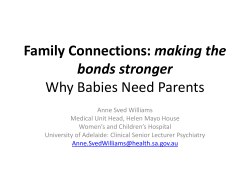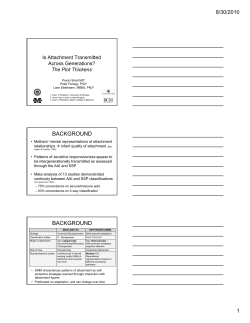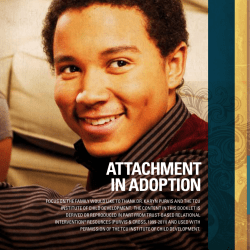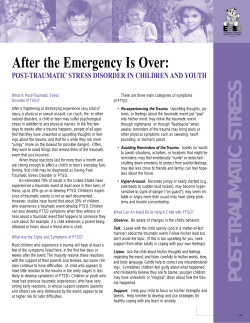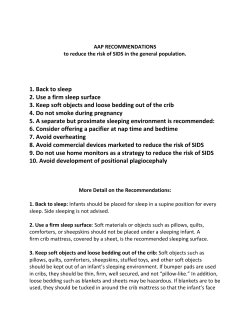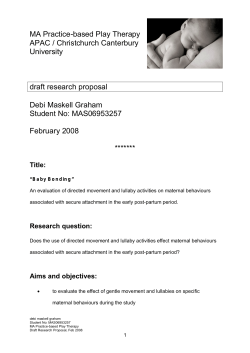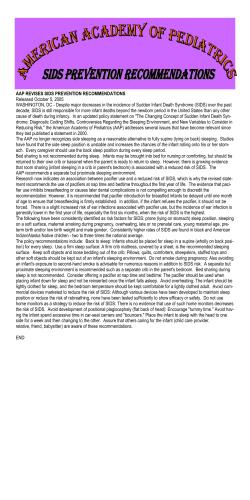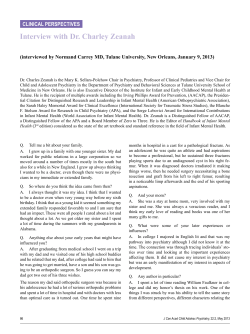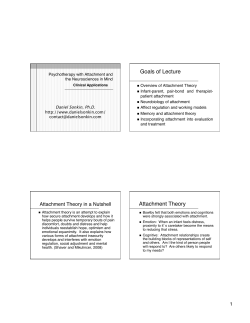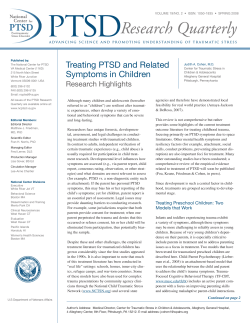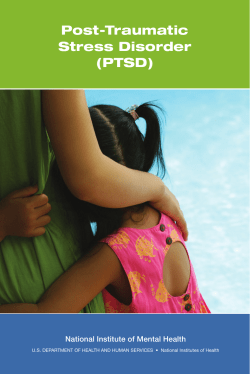
Document 13726
Attachment Trauma Jon G. Allen, Ph.D. The Menninger Clinic Baylor College of Medicine Outline Intergenerational Transmission Attachment Trauma Intergenerational Transmission of Attachment Trauma Trauma-Related Psychopathology Clinical Example: Disorganized Attachment [email protected] Intergenerational transmission and developmental psychopathology child attachment security parental attachment security I. Intergenerational transmission child mentalizing parental mentalizing in relation to childhood attachment parental mentalizing of child emotion regulation psychosocial functioning adapted from Sharp & Fonagy (2008) Social Development Adult Attachment Interview (AAI) Hour-long interview designed to be moderately stressful five adjectives for each parent; concrete examples feelings of closeness how they responded when you were hurt or ill separation experiences feeling rejected or threatened losses over the lifetime Reflection on experiences (mentalizing) how the relationships affected your personality reasons parents behaved as they did change in relationships from childhood to adulthood relationships with children how relationships with parents affected relationships with children note similarity to psychotherapy sessions Strange Situation (Infant Attachment) 1. 2. 3. 4. 5. 6. 7. 8. The infant and the mother are brought into an unfamiliar but comfortable room filled with toys; the infant is given the opportunity to play with the toys, potentially with the mother’s assistance; a stranger enters the room and plays with the infant; the mother departs, leaving the infant with the stranger and the toys; the mother returns, pausing to give the infant a chance to respond to her return, and the stranger leaves the room; the mother leaves the infant alone in the room; the stranger comes back into the room and interacts with the infant as needed; then the mother returns, and the stranger leaves the room. Parental Mentalizing Links: Meins Parental Mentalizing Links: Slade Elizabeth Meins: mind-minded commentary (6 months) Commentary referring to the infant’s Arietta Slade: Parent Development Interview knowledge (“You know what that is, it’s a ball”) interests (“What toy do you prefer?”), or thought processes (“Are you thinking?” state of mind, voicing feelings of being bored, worried, or excited; efforts to manipulate beliefs (“You’re joking”; “You’re just teasing me”) addresses emotionally charged interactions: “Describe a time in the last week when you and your child really clicked” and then “a time when you and your child really didn’t click” High levels of parental mentalizing: • • parents’ recognition of their child’s emotional states ability to link their own mental states with those of their child: “I was just so sad and frightened (mental state) by the fight I had with my husband. I wasn’t myself at all (behavior) and this was so disorienting to my baby (implies effect on baby’s mental state” Low levels of parental mentalizing: • • • parents are oblivious their child’s feelings: “She clings to me, but she’s fine”, “She wakes up in the night screaming, screaming, but nothing really bothers her” attributions of malevolence to the child (e.g., as being a devil) lack of awareness of their own emotions in parenting (e.g., denial of anger, guilt feelings, or joy) Intergenerational Transmission: Secure Attachment Intergenerational Transmission: Ambivalent Attachment Parent’s Discussion of Childhood Attachment Experience Parent’s Discussion of Childhood Attachment Experience coherent, at ease, open, free to explore, balanced view of self and others Parent’s Behavior with Infant sensitively responsive, emotionally available Infant’s Behavior with Parent explores environment and checks back with parent; focuses on parent around separation; misses parent; initiates physical contact on reunion; flexible attention to parent and environment Developmental Outcomes accepting of dependency; effectively dependent and independent feeling of self-worth and self-confidence empathic and caring toward others; capacity for trust and intimacy open to positive and negative emotions; skillful in emotion regulation internal secure base: self-soothing; comforting memories of attachment relationships poor capacity to focus, long-winded, vague, tangents, preoccupied with anger toward parents, blaming and self-blaming Parent’s Behavior with Infant inconsistent, unavailable, unresponsive, under-involved Infant’s Behavior with Parent wary and distressed, focus all attention on parent to the exclusion of play, difficult to soothe or comfort on reunion, anger mixed with effort to maintain contact; cling and kick Developmental Outcomes anxious, hypervigilant, worried about attachment figure’s availability/responsiveness exaggerate threat/fear to elicit care; seek reassurance; anxiety sensitivity negative beliefs about self and world; rumination punish to discourage attachment figure from unresponsiveness Intergenerational Transmission: Avoidant Attachment Parent’s Discussion of Childhood Attachment Experience poor memory for childhood; downplay negative experiences; idealize or devalue attachments; present self as strong and independent Parent’s Behavior with Infant rejecting of infant’s bids for comfort when distressed; unemotional with infant intrusive, controlling, over-stimulating Infant’s Behavior with Parent direct attention toward environment and away from parent whether parent is present, departing, or returning; unemotional with parent Developmental Outcomes downplay threat, worry, vulnerability, need for comfort; reject help lack of emotional awareness sometimes coupled with physiological reactivity defensive self-inflation; unwilling to provide comfort and support emotional health but collapse of defenses with extreme stress II. Attachment Trauma Trauma spectrum Attachment trauma: Two senses PTSD Complex PTSD Dual liability associated with attachment trauma in childhood (Fonagy & Target) Trauma that occurs in an attachment relationship, in childhood or adulthood Trauma that adversely affects the capacity for secure attachment—the bane of the therapeutic relationship provokes extreme, repeated stress undermines the development of the capacity to regulate distress § insecure attachment § impaired emotion-regulation § impaired mentalizing capacity “Trauma” broadly construed ALONE AFRAID unbearable emotional states + absence of experience of being mentalized feeling abandoned neglected, unloved, invisible IMPAIRED MENTALIZING CAPACITY Mentalizing failure in abusive behavior abuser terrorizing mindblind ALONE AFRAID unbearable emotional states + absence of experience of being mentalized feeling abandoned neglected, unloved, invisible IMPAIRED MENTALIZING CAPACITY Factors that affect (maternal) caregiving and contribute to discontinuities in development Financial resources; poverty Parental health, physical and mental Single parenthood Quality of marital relationship Social support for the family III. Intergenerational Transmission of Attachment Trauma Non-mentalizing in the intergenerational transmission of attachment trauma parental attachment insecurity ↔ impaired parental mentalizing capacity infant affective dysregulation non-mentalizing parent-infant interactions infant attachment disorganization impaired mentalizing capacity in childhood Impaired mentalizing in maltreated children Less inclined to engage in symbolic play Difficulty understanding emotional expressions Less conversation about internal emotional states Less likely to respond empathically to peers’ distress Show more emotionally-dysregulated behavior Intergenerational Transmission of Disorganized Attachment: Overview Parent’s Discussion of Childhood Attachment Experience (AAI) unresolved with respect to trauma or loss hostile-helpless states of mind Parent’s Behavior with Infant in the Strange Situation maltreatment; frightened/frightening disrupted emotional communication Infant’s Behavior with Parent fright without solution; fear, dissociative states, contradictory behavior [Fonagy, Gergely, & Target, 2007] Developmental Outcomes switch to controlling behavior in early childhood vulnerable to psychopathology in childhood and adulthood Disorganized Attachment: Parental Discourse in AAI Disorganized Attachment: Parental Discourse in AAI, continued Mary Main Karlyn Lyons-Ruth lapses in the monitoring of reasoning or discourse during discussions of loss or other potentially traumatic experiences lapses suggest temporary alterations in consciousness coding AAI transcripts as a whole for hostile-helpless states of mind based on identifications with hostile or helpless childhood attachment figures that appear unintegrated in the mind of the speaker represent either interference from normally dissociated memory or belief systems, or unusual absorptions involving memories triggered by the discussion of traumatic events lack of integration stems from repeated, early, and prolonged interpersonal trauma akin to PTSD (intrusive experiences) and dissociative states Persons in the helpless subtype are pervasively fearful and passive, identifying with a parent who abdicated the caregiving role also unclassifiable interviews showing no consistent attachment strategy Persons in the hostile subtype describe attachment figures as malevolent and tend to identify with them: “My mother was horrible—I’m just like my mother” Disorganized Attachment: Parents’ behavior with the infant Disorganized Attachment: Infant Behavior in Strange Situation Main: Frightening-Frightened Behavior Frightening behavior (e.g., various forms of abuse) Frightened behavior (e.g., anxious, timid, disorganized, dissociatively detached) Both frightening and frightened parental behavior are frightening to the infant Lyons-Ruth: Disrupted Communication negative-intrusive behavior (e.g., mocking the infant) role confusion (e.g., seeking reassurance from the infant) withdrawal (e.g., silence) communication errors (e.g., contradictory cues such as verbally encouraging the infant to come close and then physically distancing from the infant) Sequential display of contradictory behavior: after a bright greeting with raised arms, the infant freezes with a dazed expression; or the infant appears calm and content during the separations and then, on reunion, becomes intensely focused on the parent, showing distress or anger. Simultaneous displays of contradictory behavior patterns: the infant clings to the parent while sharply averting his head and gaze; approaches by backing toward the parent; reaches up toward the parent with arms extended but with head turned down or averted; smiles at the parent with an expression that also conveys fear; or strikes or pushes against the parent while in an apparently good mood. Undirected, misdirected, or interrupted movements: upon becoming distressed, the infant moves away from the parent; seemingly approaching the parent, the infant attempts to follow the stranger out of the door; moves the hand toward the parent and then quickly withdraws it; makes extremely slow or limp movements toward the parent; or suddenly and inexplicably cries or shows anger in the midst of otherwise contented play. Stereotypical or anomalous movements: the infant engages in extended rocking or hair twisting; shows tics; or displays jerky, automaton-like movements. Freezing and stilling: the infant sits or stands with arms held out for prolonged periods; or maintains a slack or dazed expression. Apprehension regarding the parent: the infant jerks back from the parent with a frightened expression; moves behind a chair to avoid the parent; or shows vigilance or tension in interacting with the parent. Direct indices of disorganization or disorientation: the infant engages in disorganized wandering; shows a disoriented expression or blind look in the eyes; or greets and approaches the stranger with raised arms as the parent enters the room disorientation (e.g., unusual changes in voice during an interaction) Disorganized Attachment and Psychopathology Infant disorganization predicts Teachers’ ratings of dissociative behavior in school Dissociative Experiences Scale scores in young adulthood Vulnerability to PTSD in childhood Harbingers of Borderline Personality Disorder (BPD) at age 12 disturbances in attention, relationships, identity instability in emotion and behavior Symptoms of BPD in structured interviews at age 28 Adult disorganized/unresolved attachment is associated with Global psychopathology and clinical status BPD PTSD Suicidality Beebe: 4-month predictors of disorganized attachment Second-by-second video analysis, 150s, free interaction: mothers instructed to play with their infant placed in an infant seat on a table; play as usual but without toys Strange Situation attachment classification at 12 months Future disorganized infants’ behavior: high levels of emotional distress (facial and vocal) discordant responses, e.g., one infant joined sweet maternal smiles with smiles of his own, but meanwhile he whimpered as his mother pushed his head back and roughly smacked his hands together behavior erratic and unstable, moment-to-moment, potentially making it more difficult for mothers to read (mentalize) low levels of self-soothing, emotion-regulating self-touch Beebe: Maternal behavior predicting disorganized attachment (1) gazed away from their infant’s face more often and unpredictably (2) loomed into the infant’s face more often and unpredictably (3) did not respond to their infant’s self-touch with complementary affectionate touch (4) showed less variable emotional responsiveness, that is, relatively rigid, closedup facial expressions (5) were less likely to follow the infant’s shifts between positive and negative emotions, for example, less able to “emotionally ‘enter’ and ‘go with’ infant facial and vocal distress” (6) showed discordant emotional responses, responded to their infant’s distress with surprise or positive emotion. Discordant responses are indicative of denial of the infant’s emotional distress, attempting to ride negative into positive, e.g., “Don’t be that way” or “No fussing, no fussing, you should be very happy” Attachment and maternal engagement with infant distress (Strathearn, Fonagy, et al., 2009) AAI’s administered to first-time mothers during pregnancy 7 months: Measured mothers’ serum oxytocin levels after interacting with infant 11 months: measured mothers’ brain activity associated with viewing pictures of infant’s smiling and sad faces Contrasted AAI secure and avoidant-dismissing mothers Secure mothers showed higher increases in serum oxytocin than dismissing mothers after interacting with their infants Serum oxytocin levels correlated with subsequent activation in dopaminergic reward pathways (ventral striatum) in response to observing pictures of their infant’s face Secure mothers showed activation in dopaminergic reward pathways when viewing their infant’s sad face as well as happy face Dismissing mothers showed patterns of brain activation consistent with negative emotion (insula) and emotion-regulation efforts (dorsolateral PFC) in response to sad faces Conclusion: Secure mothers remain positively engaged in the face of infant distress (mediated by oxytocin activating dopaminergic pathways) Beebe’s Mind-Minded Commentary Mothers are not generally less empathic; rather, failure of attunement during moments when infant is in a state of distress I’m so upset and you’re not helping me. I’m smiling at you and whimpering; don’t you see I want you to love me? When I’m upset, you smile or close up or look away. You make me feel worse. I feel confused about what I feel and about what you feel. I can’t predict you. I don’t know what is going on. What am I supposed to do? I feel helpless to affect you. I feel helpless to help myself. I feel frantic. Later Opportunities: Attachment relationships beyond infancy Parents Siblings Extended family (e.g., grandparents) Friendships Romantic relationships Teachers/Mentors Clergy Therapists God Pets Lending a hand (Jim Coan) Experimental situation Satisfied marital couples brought into lab; wife hooked up to receive shocks (and was shocked periodically). Conditions varied: holding husband’s hand, stranger’s hand, or no one’s hand. Multiple brain areas scanned. Result Lowest levels of brain activation associated with holding hand of husband; highest levels with holding no hand. High quality of marital relationship associated with least brain activity Conclusion Attachment is the most potent and efficient means of emotion regulation. Note that most treatments (e.g., DBT, CBT) promote self-regulation, the most effortful Social Context for PTSD in DSM-III (1980) Confluence of Social Concerns in 1970s combat trauma in Vietnam veterans battered child syndrome childhood sexual abuse childhood maltreatment more generally rape trauma syndrome battering in marital relationships An official diagnosis justifies resources for treatment and prevention IV. Trauma-Related Psychopathology Some key problems with the diagnosis of PTSD Cannot agree on definition of “traumatic” stress; too much emphasis on physical threat, too little on psychological experience Exposure to traumatic stress only loosely related to PTSD; very complex etiology PTSD is not distinct from other disorders (especially depression, dissociation, and other anxiety disorders) Reasons for dispensing with criterion A Vast majority of persons exposed to potentially traumatic events do not develop PTSD (although some stressors such as rape carry far higher risk than others such as motor vehicle accidents) Minority of individuals not exposed to A1 events develop full PTSD syndrome (e.g., relationship breakup, job loss, humiliating experiences) Impossible to identify a cutoff point between “small-t” and “big-T” trauma (note: mentalizing failure is “big-T” trauma) Irony of recommendation to remove criterion A when PTSD is a rare DSM disorder with etiology included in criteria Complex etiology of PTSD: Pre-trauma factors Genetic risk Likelihood of trauma exposure Likelihood of PTSD after trauma exposure Difficult temperament Disorganized attachment Female gender Lower age at exposure Prior trauma exposure (e.g., childhood abuse) Lower socioeconomic status, educational level, IQ Family or personal psychiatric history Impaired family functioning Changing parental figures, changing residency Complex etiology of PTSD, ct’d The role of attachment in the etiology of PTSD Peri-trauma factors Objective severity (Criterion A1) Subjective experience (Criterion A2) Peritraumatic dissociation (in days after trauma) Post-Trauma Factors “What happens after a trauma has been shown consistently to have the biggest impact on whether a person develops PTSD” (Brewin, 2003) Subsequent stressors Lack of social support ( Brewin: negative social support, that is, non-mentalizing responses; compare to “high expressed emotion” as a risk factor for relapse in a range of disorders ) Pre-trauma risk factors include earlier attachment trauma and quality of family environment Peri-truama factors include the role of attachment relationships in the trauma (i.e., attachment trauma) Post-trauma factors include social support (i.e., quality of mentalizing in attachment relationships) Nature of traumatic memory calls for mentalizing Is PTSD a Distinctive Disorder? Overlaps with depression and other anxiety disorders PTSD, GAD, MDD are all heavily saturated with a broad dysphoria factor (“anxious misery”) Factor analyses reveal at least 4 factors, not 3 reexperiencing, avoidance, hyperarousal + numbing or dysphoria; yet adding dysphoria increases overlap with depression Heterogeneity within PTSD internalizing vs. externalizing; dissociative subtype Painful intrusive memories characteristic of depression and many other disorders besides PTSD Flashbacks are most distinctive of PTSD “Complex PTSD” Paradox (van der Kolk) Too much memory (intrusive memories, flashbacks) Too little memory (vagueness, confusion, gaps, fragmentation, amnesia) Situationally Accessible Memory (SAM) [non-mentalized] Triggered involuntarily Image-based, repetitive, emotion-laden, sense of reliving Strengthened by dissociation at time of trauma (peritraumatic) Associated with primary emotions at time of trauma (fear) Verbally Accessible Memory (VAM) [mentalized] Deliberately retrieved Narrative/autobiographical Integrated with other autobiographical memory, complete personal context (past, present, future--mentalized) Secondary emotions associated with past (regret, anger, shame) and future (hopelessness) Anxiety, Depression, and Anxious Misery suicidality nonsuicidal self-harm eating disorders addictions dissociation anxiety depression ill health PTSD insecure attachment anxiety personality disorders anxious misery hyperarousal depression joylessness existential-spiritual impact neuroticism Existential-Spiritual Perspectives Existential-Spiritual Trauma loss of faith, alienation, bitterness, sense of futility The Problem of Evil evil is evil by virtue of trauma grave harms, diabolical, related to sadism & mindblindness Defy understanding: making sense of the senseless Attachment to God God is a bona fide attachment figure security of attachment parallels parents; associated with health Hope Paul Pruyser: hope is based on belief in some benevolent disposition toward yourself somewhere in the universe, conveyed by a caring person Complex Traumatic Stress Disorders (Courtois) Complex psychological stressors repetitive and prolonged harm or abandonment by caregivers occur at developmentally vulnerable times Complex traumatic stress disorders changes in mind, emotions, body, and relationships severe problems with dissociation, emotion dysregulation, somatic distress, relational or spiritual alienation Cautionary note even more than PTSD, the etiology of these disorders is extremely complex and should not be reduced to exposure to traumatic events (i.e., trauma does not explain everything) Complex trauma-related psychopathology: Terminology & Concepts Comorbidity (diagnose all disorders individually) Complex PTSD (Herman) Disorders of Extreme Stress Not Otherwise Specified (DESNOS; van der Kolk) Developmental Trauma Disorder (van der Kolk) Complex Psychological Stress and Complex Traumatic Stress Disorders (Courtois & Ford) Attachment Trauma Beyond stressor-to-disorder thinking: The need for a person-centered approach Discrete causal influences and discrete resulting categories are presumed, with clear distinctions among resulting taxa….this is no longer accepted even in medicine….Nonetheless, in psychiatry and psychology, all too often the single pathogen—discrete entity connection is assumed, even though this is challenged by the rampant problem of comorbidity….In contrast, in the developmental-organizational approach that we advocate, cause is complex. Early patterns of maladaptation, or extreme adversity, such as a history of physical abuse, are seen as creating vulnerabilities that in interaction with later factors are probabilistically linked to a range of various manifestations….it is unfortunate that the consequences of trauma, and harsh experience more generally, are sequestered into [PTSD] —Sroufe et al., 2005 Developmental approach to diagnostic understanding We are hardly in a position to redo DSM along the two-polarities model and the associated patterns of insecure attachment. But we need to move away from focus on symptom-clusters to true diagnostic understanding, wherein personality development and attachment history will play a prominent role. Patrick Luyten and colleagues advocate a fundamental shift in perspective, that is, a move from a disorder-centered to a person-centered approach to treatment, that is, “a life history perspective” that aspires to “map the myriad complex pathways from early childhood to later adaptive or maladaptive development which can then form the basis for interventions for both preventing and treating disorders.”
© Copyright 2024



